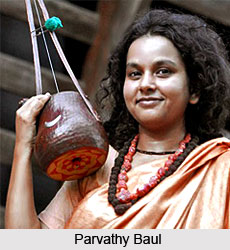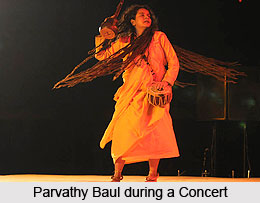 Parvathy Baul is one of the leading Baul musicians in India. She is trained under stalwarts like Sanatan Das Baul and Shashanko Goshai Baul. Taking inspiration from the Bauls of Kenduli in Bengal and the religious scriptures she has read in the south, she composes her own sonnets about life and death. Parvathy has been performing both in India and other countries since 1995.
Parvathy Baul is one of the leading Baul musicians in India. She is trained under stalwarts like Sanatan Das Baul and Shashanko Goshai Baul. Taking inspiration from the Bauls of Kenduli in Bengal and the religious scriptures she has read in the south, she composes her own sonnets about life and death. Parvathy has been performing both in India and other countries since 1995.
Early Life of Parvathy Baul
She was born as Mousumi Pairal in 1976 in a traditional Bengali Brahmin family in the West Bengal state of India. Her father was an engineer and mother was a housewife. Her father took great interest in Indian classical music and often took her to concerts while her mother was a devotee of mystic saint Ramakrishna. Her father"s posting at various locations in the region gave her opportunity to grow up and mix with different people of places like Assam, Cooch Behar, and bordering areas of West Bengal.
Education of Parvathy Baul
In the beginning, Parvathy learnt Kathak from Srilekha Mukherjee. She also learnt visual art at Kala Bhavan, an art school in Santiniketan (Visva-Bharati University).
Her life took a turn, when for the first time she heard a blind Baul singer while on a train to Shantiniketan campus. This was followed by meeting Phulmala Dashi, a woman Baul singer who frequented the campus. Soon, she became her disciple. Then she learned this folk music from Sanatan Das Baul, an 80-year-old Baul singer from Bankura in West Bengal. He became her first guru. The next seven years she went on to travel with her guru learning Baul songs, Baul dance, and playing ektara and duggi.
Her next guru was Shashanko Goshai Baul who was 97-year-old at the time and lived in Khoirboni, a small village in the Bankura district. He trained her for three years teaching numerous songs, and intricacies of the Baul tradition.

Career of Parvathy Baul
Parvathy came to Thiruvananthapuram in Kerala in 1997 to learn about local spiritual and theatre traditions. Here she met Ravi Gopalan Nair, a traditional puppeteer from Kerala. She learnt Grotovishi technique used in theatre from him. In 2000, both the teacher and disciple visited Bread and Puppet Theater in Vermont, US to study with creator Peter Schumann who is notable for incorporating puppetry, live-art into theatre performances. In Thiruvananthapuram, she also met Abdul Salam, a Muslim fakir kalandar. He became her guru and taught her about the spiritual meaning of the tradition.
However since 2001, she decided to concentrate entirely on Baul tradition, and started performing Baul music. Musical instruments like ektara, duggi and metallic anklets accompany her songs. She performs mystic songs both from tradition Baul repertoire and her own doha couplets. She takes inspiration from pattachitra, scroll painters and traditional story-tellers of Bengal and adds visual elements to performance through painted backdrops. In some of her performances, she is seen painting large canvases along with her singing, illustrating the themes of her songs as a live performance art.
Apart from this, she performs live in remote villages of Kerala, at soirées hosted by local villagers, and in her native Bengal. Once a year, she travels to teach Baul music at the International School of Theatre Anthropology (ISTA). She also performs at various concerts all over India and other countries.
In the year 2005, she wrote and published a pictorial book about her journey into the Baul tradition titled "Songs of the Great Soul". She also runs a Baul music gurukul (school) titled "Ektara Baul Sangeetha Kalari". The school is situated at Nedumangad near Thiruvananthapuram.
Personal Life of Parvathy Baul
In late 1990s, she tied the knot with her teacher Ravi Gopalan Nair.




















